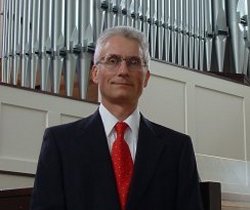 |
Henry Doktorski
|
 |

Transcriptions include a polyphonic Baroque six-movement Suite for a Musical Clock by G.F. Handel, in which Doktorski shows the versatility and charm of the free-bass concert accordion, in which both right and left hands are melodically independent. Robert Schumann's Tr umerei (from Kinderscenen ) is a Romantic favorite in which Doktorski reproduces the same voicings that the composer specified originally for piano. The tonal quality of this piece is similar to the sound of a fine European harmonium. Johannes Brahms' Hungarian Dance No. 5 is a show-stopping tour de force which Doktorski performs with vigor and passion. George Gershwin's Three Preludes (like the Schumann and Brahms pieces above) were originally written for piano, but transcribe superbly for the concert accordion. Gershwin was no stranger to the accordion, as his publisher in 1931 gave the great jazz accordionist Cornell Smelser permission to play Rhapsody In Blue on the radio. This was no small honor; at that time only the organist Jesse Crawford and Gershwin himself were permitted to play it. In addition, Doktorski is no stranger to Gershwin, as his second CD featured Gershwin's Rhapsody In Blue along with ten other Gershwin pieces. The American composer, Alan Hovhaness (1911-2000) -- who wrote about 400 works, including ten operas, sixty-three symphonies (best known are Mysterious Mountain, op. 132, And God Created Whales, op. 229 and Mount St. Helens Symphony, op. 360), a hundred choral works, plus dozens of vocal, chamber and instrumental pieces, -- wrote several pieces for accordion. Doktorski plays the Suite for Accordion (1959) which consists of three movements. The Solene movement is like a chant, almost Gregorian at times, with a hint of dissonance in the introduction and bridge. The Presto is quasi-baroque and mostly in a natural minor scale. The Allegro Vivo seems to intentionally evoke a bagpipe with a hint of Middle Eastern quarter tones. Hovhaness composed a piece for Henry Doktorski titled Hymn. In a letter dated February 26, 1990, he wrote, "I improvised a hymn for you in 7/4 time -- a sacred rhythm -- three beats for heaven plus four beats for earth, as you are a religious man." This is the world-premiere CD recording of Hymn by Hovhaness. Astor Piazzolla (1921-1992), Argentinean by birth, is famous for his tangos, which were inspired by both classical music and jazz. He wrote over 750 compositions, including concerti, operas, film and theater scores, and made over seventy records. His ballad Oblivion was nominated for a Grammy Award for best instrumental composition in 1995. In addition to being a virtuoso accordionist, Henry Doktorski is also a composer, having studied with David Stock and Joseph Wilcox Jenkins at Duquesne University where he received a Master of Music degree. Doktorski's Rondo Polska (2002) is a light piece, a humorous polka based on a motif comprised of three repeated notes. The introduction mimics a classical style adagio, similar to the flavor of Clementi or Hadyn. The Italian-American Guido Deiro (1886-1950) was one of the great pioneers of the accordion. Discovered by a talent scout in San Francisco in 1910, he was a big hit on the vaudeville circuit as a headliner for twenty years. He made one hundred records on Columbia and other major labels, and composed his own music. Doktorski plays ten Deiro compositions exhibiting great stylistic diversity: rags, marches, mazurkas, polkas, tangos and waltzes. California Accordion Recitals truly contains a veritable smorgasbord of early twentieth-century American popular music. |
This CD is out of print.
It has been replaced by Classical Accordion Recital
and Vaudeville Classics.
| Program Notes |
| Reviews |
| Back to California Accordion Recitals |
| Back to The Homepage of Henry Doktorski |